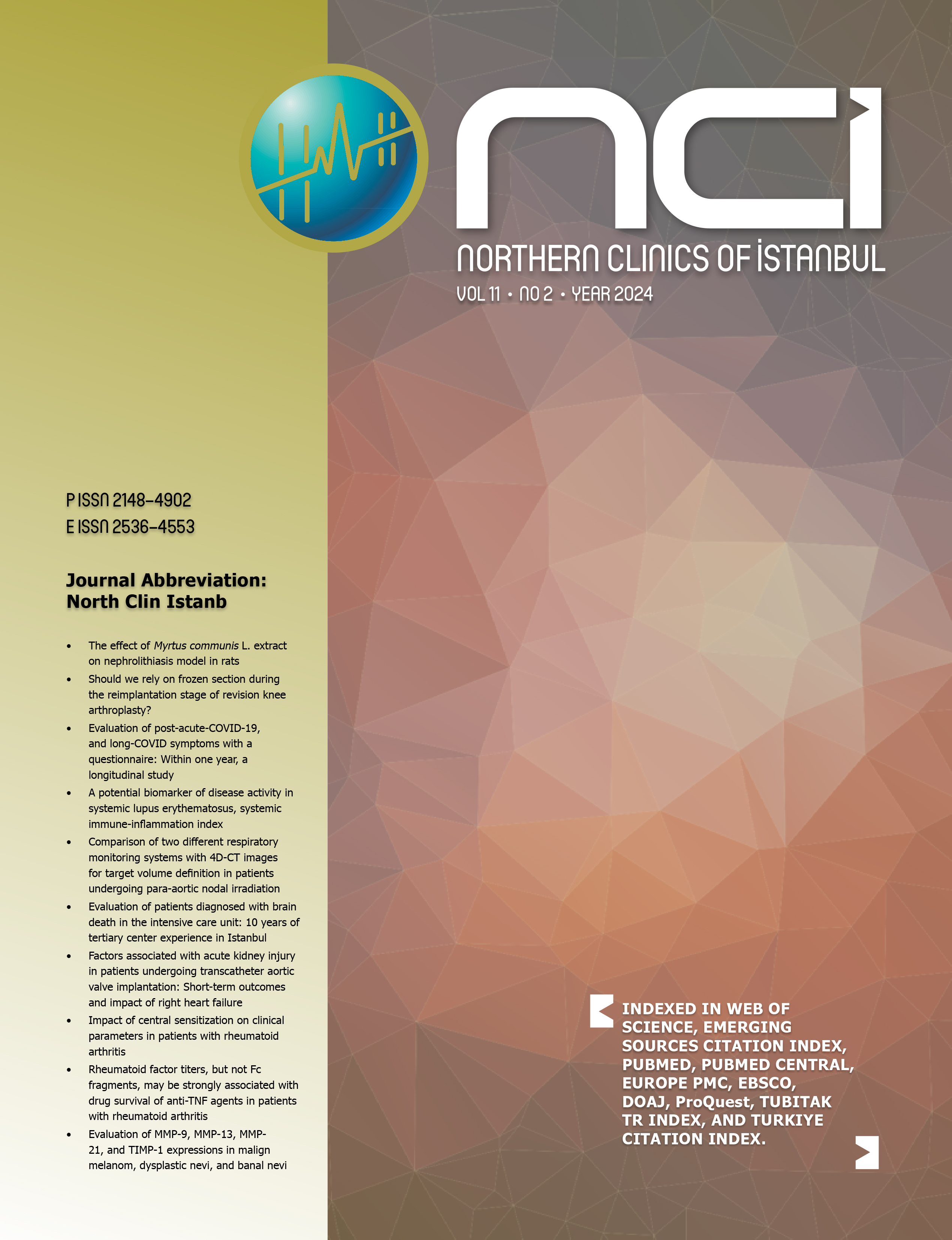Vena cava superior syndrome in the children with mediastinal tumors: Single-center experience
Alper Ozcan1, Ekrem Unal1, Musa Karakukcu1, Abdulhakim Coskun2, Mehmet Akif Ozdemir1, Turkan Patiroglu11Division of Pediatric Hematology-Oncology, Department of Pediatrics, Erciyes University Faculty of Medicine, Kayseri, Turkey2Division of Pediatric Radiology, Department of Radiology, Erciyes University Faculty of Medicine, Kayseri, Turkey
OBJECTIVE: Vena cava superior syndrome comprises various symptoms of compression of vena cava superior. The results of increased venous pressure in the upper body may cause edema of the head and neck associated with cyanosis, plethora and distended subcutaneous vessels. Vena cava superior syndrome is rare in childhood. Therefore, we planned this retrospective study.
METHODS: The retrospective study was carried out on the children with mediastinal tumors in the Department of Pediatric Hematology-oncology, Erciyes University Faculty of Medicine, Kayseri,Turkey, from January 2010 to December 2017. Diagnostic procedures included hematological investigations, chestradiography, thoracic computed tomography, echocardiography and lymph node or mediastinal biopsy.
RESULTS: In this study, 19 (five were female) of 41 patients with mediastinal tumors had Vena cava superior syndrome. Diagnosis included Hodgkins lymphoma in seven (37%), non-Hodgkins lymphoma in six (32%), acute T- lymphoblastic leukemia in four (21%), neuroblastoma and anaplastic round cell sarcoma in one each respectively. All of the 19 patients facial swelling, venous distention and mediastinal widening. All patients received intravenous corticosteroids (0.6 mg/kg dexamethasone). Furthermore, the patient with anaplastic round cell sarcoma received emergency radiotherapy. No patients died because of Vena cava superior syndrome.
CONCLUSION: Vena cava superior syndrome is a medical emergency that requiresurgent treatment. Vena cava superior syndrome studies in children are rare. In this retrospective study,we found that the most common cause of Vena cava superior syndrome was Hodgkins lymphoma different from literature.
Keywords: Child, emergency treatment; mediastinal tumor; vena cava superior syndrome.
Mediastinal Tümörlü Çocuklarda Vena Cava Superior Sendromu: Tek Merkez Deneyimi
Alper Ozcan1, Ekrem Unal1, Musa Karakukcu1, Abdulhakim Coskun2, Mehmet Akif Ozdemir1, Turkan Patiroglu11Erciyes Üniversitesi Tıp Fakültesi, Çocuk Hematoloji-Onkoloji Anabilim Dalı, Kayseri, Türkiye2Erciyes Üniversitesi Tıp Fakültesi, Radyoloji Anabilim Dalı, Çocuk Radyolojisi Bilim Dalı, Kayseri, Türkiye
GİRİŞ ve AMAÇ: Vena cava superior sendromu, vena cava superiorun çeşitli kompresyon belirtilerini içerir. Vücudun üst kısmında artmış basıncın sonucunda siyanozla beraber baş ve boyunda ödem, plethore ve yüzeyel damarlarda belirginleşmeye sebep olabilir. Vena cava superior sendromunun çocuklarda nadir olması nedeniyle bu çalışmayı planladık.
YÖNTEM ve GEREÇLER: Retrospektif çalışma, Erciyes Üniversitesi Tıp Fakültesi Pediatrik Hematoloji-Onkoloji Anabilim Dalı'nda Ocak 2010-Aralık 2017 tarihleri arasında mediastinal tümörü olan çocuklarda yapıldı. Tanı yöntemleri arasında hematolojik incelemeler, göğüs radyografisi, göğüs tomografisi, ekokardiyografi ve lenf nodu veya mediastinal biyopsi sayılabilir.
BULGULAR: Mediastinal tümör tanısı alan 41 hastadan 19 unda (% 46.3) Vena cava superior sendromu bulgularının olduğu saptandı. Geriye dönük tanılara bakıldığında 7 si (% 37) Hodgkin Lenfoma, 6sı (% 32) Non-Hodgkin Lenfoma, 4ü (%21) T hücreli Akut Lenfoblastik Lösemi, 1i (%5) nöroblastom, 1i (%5) anaplastik round cell sarkom idi. 19 hastanın tümünde yüzde şişlik, venöz genişleme, mediastinal genişleme görüldü. Tüm hastalar intravenöz kortikosteroid tedavisi aldı (0.6 mg/kg deksametazon). Ayrıca anaplastik round cell sarkom tanısı alan bir hasta radyoterapi aldı. Vena cava superior sendromu nedeniyle ölen hastamız olmadı.
TARTIŞMA ve SONUÇ: Vena cava superior sendromu acil tedavi gerektiren bir tıbbi acil durumudur. Çocukluk yaş gurubu Vena cava superior sendromu çalışmaları nadirdir. Bu retrospektif çalışmada, Vena cava superior sendromunun en sık nedeni literatürden farklı olarak Hodgkin Lenfoma olarak saptanmıştır. (NCI-2019-0004.R1)
Anahtar Kelimeler: Acil tedavi, çocuk, mediastinal tümör, vena cava superior sendromu
Manuscript Language: English





















